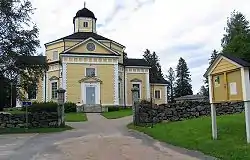Juuka
Juuka (Finnish: [ˈjuːkɑ]; Swedish: Juga) is a municipality of Finland. It is located in the North Karelia region. The municipality has a population of 4,297 (26 October 2023)[2] and covers an area of 1,846.58 square kilometres (712.97 sq mi) of which 344.78 km2 (133.12 sq mi) is water.[1] The population density is 2.86 inhabitants per square kilometre (7.4/sq mi).
Juuka
Juga | |
|---|---|
Municipality | |
| Juuan kunta Juga kommun | |
 Juuka Church | |
 Coat of arms | |
 Location of Juuka in Finland | |
| Coordinates: 63°14.5′N 029°15′E | |
| Country | |
| Region | North Karelia |
| Sub-region | Pielinen Karelia sub-region |
| Charter | 1868 |
| Government | |
| • Municipal manager | Markus Hirvonen |
| Area (2018-01-01)[1] | |
| • Total | 1,846.58 km2 (712.97 sq mi) |
| • Land | 1,501.79 km2 (579.84 sq mi) |
| • Water | 344.78 km2 (133.12 sq mi) |
| • Rank | 43rd largest in Finland |
| Population (2023-10-26)[2] | |
| • Total | 4,297 |
| • Rank | 186th largest in Finland |
| • Density | 2.86/km2 (7.4/sq mi) |
| Population by native language | |
| • Finnish | 97.4% (official) |
| • Others | 2.5% |
| Population by age | |
| • 0 to 14 | 9.7% |
| • 15 to 64 | 52.6% |
| • 65 or older | 37.6% |
| Time zone | UTC+02:00 (EET) |
| • Summer (DST) | UTC+03:00 (EEST) |
| Website | www.juuka.fi |
The municipality is unilingually Finnish.
Geography
Juuka as a whole consists of 20 villages. The large expanse of Juuka consists of:
- Ahmovaara
- Halivaara (Hali)
- Juuka
- Kannas
- Kajoo
- Kuhnusta
- Larinsaari
- Matara
- Nunnanlahti
- Paalasmaa
- Petrovaara
- Pihlajavaara
- Polvela
- Raholanvaara (Rahola)
- Timovaara
- Tuopanjoki
- Vaikko
- Vihtasuo
- Vuokko
The neighboring municipalities of Juuka are Kuopio, Kaavi, Kontiolahti, Lieksa, Nurmes, Polvijärvi and Rautavaara. The former neighboring municipalities are the Nurmes rural municipality, which was annexed to Nurmes in 1973, Pielisjärvi, which was also connected to Lieksa in 1973, and Säyneinen, which was annexed to Juankoski in 1971; Juankoski, on the other hand, was connected to Kuopio in 2017.
Etymology
Juuka means a river that flows through a lake.[5] The village of Juuka dates back to the 16th century. In the late 19th century, settlements began to be settled along the roads and shops were established by the banks of the Lake Pielinen.
The parish of Juuka was initially a prayer room separated from the parts of the parishes of Pielisjärvi and Nurmes and its own parish from 1873. The present church was completed in the 1850s, but was preceded by two earlier churches.
Juuan Elli
Ellinpäivät is a scenario where in four days different associations, communities, and companies arrange events for each day. To get information about these events there is a notification in the newspaper Vaarojen Sanomat. In the paper there is info and a timetable for the events. The board selects the people in charge of the scenario. Elli refers to the figurehead of the scenario and a new figurehead is chosen every year.
The events can include concerts, market events, the declaring of a new Elli, and a new event called “Juuret Juuassa –ryhmän Rehvit”. Essentially, the event is a car show where many retro cars and their drivers can be found. For that reason, it's often called a rally for older youngsters.
Notable people
References
- "Area of Finnish Municipalities 1.1.2018" (PDF). National Land Survey of Finland. Retrieved 30 January 2018.
- "Preliminary population statistics 2023, September". StatFin. Statistics Finland. Retrieved 26 October 2023.
- "Demographic Structure by area as of 31 December 2022". Statistics Finland's PX-Web databases. Statistics Finland. Retrieved 6 September 2023.
- "Population according to age (1-year) and sex by area and the regional division of each statistical reference year, 2003–2020". StatFin. Statistics Finland. Retrieved 2 May 2021.
- Matti Puoskari: Puu-Juuan raitilta, ISBN 951-96823-5-X, page 8 finnish
External links
![]() Media related to Juuka at Wikimedia Commons
Media related to Juuka at Wikimedia Commons
- Municipality of Juuka – Official website in Finnish and partly in English and Russian
